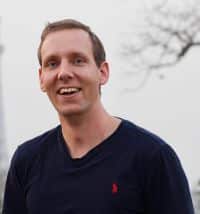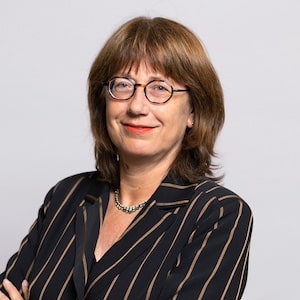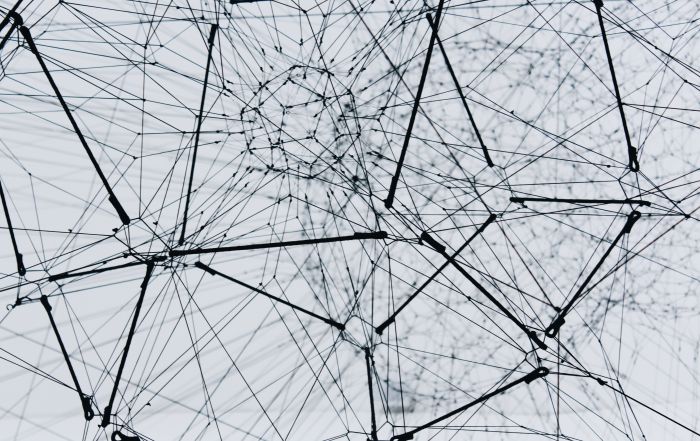What’s in a number? 25 times Medical Data & Pizza
Covering 5 years and 25 editions, the Medical Data + Pizza event series has followed a compelling timeline, encompassing the period when AI came of age, and became sexy. We spoke with co-founder Mark Hoogendoorn about the challenging task of bringing AI to the bedside – in Amsterdam and across Europe – and about the power of pizza to get things moving.
Pizza as irresistible lure
It began as a simple concept: to play cupid between two very different beasts. On one side you have the data scientists – always hungry for pizza, but also for real-world problems to solve. And on the other, the medical professionals – who share the pizza hunger, but already have plenty of very real-world problems on offer.

Mark Hoogendoorn
“The idea really came from one of the co-founders Paul, who’s always coming up with ways to get different people to talk to each other. Right Data Right Now partner Jeroen Maas – at that time working for the Amsterdam Economic Board – offered to pitch in providing the pizzas and the Pizza Meetups were born. And there’s no denying it: pizza not only stimulates people to show up, but also to stay and talk,” says Mark Hoogendoorn, professor of artificial intelligence at the Vrije Universiteit Amsterdam’s Department of Computer Science.
Together with medical counterpart Paul Elbers, intensivist and associate professor of intensive care medicine at Amsterdam UMC, Hoogendoorn formed the Amsterdam Medical Data Science (AMDS) network. Supported by Amsterdam UMC, OLVG, Vrije Universiteit, PacMed, and Amsterdam Economic Board the network grew rapidly over the years to 2,154 members and counting. The Medical Data + Pizza event series (full name: ‘Everything medical data science. And pizza’) would become the network’s calling card.
Data and pizza proved to be a match made in AI heaven. 25 editions later, the event has seemingly covered it all – from modelling hospital admissions during COVID to racist algorithms and from making humans and machines get along to predicting the best drug combinations to target an individual’s brain cancer.
An eye for data – and human impact
Hoogendoorn’s own research is very much focussed on the countless challenges around enabling that tricky dance of bringing data solutions to the bedside. And like any good professor, he knows how to communicate clearly and with infectious enthusiasm.
“For people outside the field, I try to use examples from healthcare to explain what I do with artificial intelligence. So, for example, hospitals have all this patient data. And when you are looking for the best treatment for a new patient, you will want to look back at all those historical patients to see what kind of treatments they got and how well each worked. Based on that information, you can get a good idea of what would work best for a new patient. Now, obviously, there are so many patients that it’s simply impossible to look through all the patient files. You need certain systems to go in there and extract certain patterns of what works and for whom. And that’s what AI can do.”
Altruism meets near-blind optimism
Hoogendoorn’s was only seduced by the healthcare domain while doing his PhD. “I saw it was an area with many problems to solve – dealing with an ageing population, staff shortages etc. There’s also a lot of unused data out there. And while AI cannot offer a solution for everything, it can really make a contribution to benefitting people’s lives. But there’s definitely a lot of work to do.”
What shines through at each Data + Pizza event is this: people want to make a positive impact on the world, even though they are aware of the monumental task at hand – technically, ethically, regulatorily. There’s a certain shared belief in a happy ending if we all just get to work.
“It’s true, I’m a fairly optimistic person by nature,” smiles Hoogendoorn.
Diversity is the name of the game
The first gatherings did not hint at the popularity to come. The sparse crowd was largely made up of fresh-faced Dutch males. However, today you won’t find a more diverse crowd in term of age, gender, nationality and profession.
“Diversity was actually the original idea. To bring together a diverse crowd with different backgrounds to really talk to each other – the medical experts, the nurses, other support staff, the AI experts, the regulatory experts, everyone. It’s crucial for making things fly in our setting,” says Hoogendoorn.
In fact, he was surprised by how diverse it really got. “I thought we’d attract mostly academic types. But we’ve also attracted people from the business world and not necessarily only from the healthcare domain. And this is super positive: that these people are bringing in their very valuable expertise. In general, all sorts of people came forward to offer their free time to work on certain projects.”
Surfing – and helping create – a whole new wave
Of course, the fact that AI has become such a hot topic has helped somewhat. “This enthusiasm might have something to do with the rising popularity of AI and data science,” Hoogendoorn admits, “but I also think we can pat ourselves on the back a bit.”
He remains unsure about how pioneering the event actually was, however. “It’s hard to define causal relationships. But we did gain a lot of traction early on. In general, I think we were alongside the wave. Other initiatives were also popping up, and people were still figuring out the best way to do things. And we offered this more informal approach that welcomed everyone – not just academics or medical experts.”
It’s certainly garnered results. “I think we really did contribute to bringing people together and making people enthusiastic. You see people reaching out to each other more for more intensive collaborations. So, this is a sign that the network is really working. And for me, that’s exactly the reason why we started this.”
At the same time, innovation in the medical domain does lag compared to other fields. “Of course, there’s a very good reason for this,” says Hoogendoorn: “Ensuring patient safety. It’s also tricky to get access to data – and that’s also for good reason.”
The question of time
People have been talking about applying AI to healthcare for a long time. “In 1966, the first Turing Award winner, Alan J Perlis, was already saying that radiologists were soon going to be out of a job. So, the question became: When will it finally get traction? And that’s still hard to call. But people are getting more enthusiastic. And you are seeing all these developments, such as ChatGPT and all this interesting stuff Google is producing.”
Certainly, the global health emergency around COVID-19 played its part in pushing things forward.
“Paul and Pacmed acted very quickly on this in getting data from different intensive cares to see what we could learn. It was very inspiring to suddenly see things moving so quickly. But on the other hand, it also showed how far we still have to go. It still took almost six months to bring the data together to make it more uniform. So, this was motivating in being able to do this faster and integrate things more.”
And happily, integration is happening. “The bigger hospitals are involved. The doctors are involved. Management and the decision-makers – the organisations as a whole – are showing a lot of support. So this was a pivotal moment. I think what we originally wanted is now really happening.”
Onward and upward
Hoogendoorn is hard-pressed when asked if he’d change anything about the Data + Pizza series, now he’s looking back with 20/20 hindsight. “So far, nothing has gone really wrong. Okay, maybe the pizza was a bit late once or twice,” he jokes.
Moving forward, he hopes they will be able to play a bigger role in facilitating specific projects. “My favourite edition was when people were pitching all these amazing projects and we could provide seed money to the winner. I think it would be a natural evolution if we did more of that.”
Meanwhile, he’s looking forward to seeing how Europe forges ahead with a more people-centred approach to AI – in contrast to the US, where corporations tend to control patient data, or China, where the government calls the shots. Hoogendoorn believes the EU approach is the way forward, even as critics say the required infrastructure will work to slow innovation in the region.
“We need these safeguards in place. We have to be careful with potential downsides,” he says. “In the long run, I think it will prove beneficial, because you’ll have more support from the public. I don’t think patients are against sharing their data if it helps the next patient. People’s distrust is more directed at the government and policymakers. And look at what happened with [AI-assisted diagnostic system] IBM Watson, where the results were, let’s say, not very impressive. It takes time to build the trust. You have to reassure people that [sharing their data] will help them – and that it’s about helping medical professionals to do a better job, not replacing that job.”
In short, progress may be slow (for now!), but it’s going in the right direction. “I think there are already many initiatives in place that take all the privacy concerns into account, such as the European Health Data Space,” says Hoogendoorn. “It’s now all pretty much in the making. Things are obviously moving relatively slowly. But we see the right movements. And we see signs of it speeding up.” Hoogendoorn himself is part of the Health Data Space Amsterdam and, together with Major hospitals, universities, Philips, the City of Amsterdam is working on
improving data sharing and the use of AI in healthcare in the Amsterdan region.
After all, at the end of the day, it’s just about getting the right people together and putting in the work.
Pizza, anyone?
Are you a researcher looking for inspiration or exposure? You can now sign up on the new AMDS website.
Sometimes medical professionals and data scientists do not sufficiently understand or even know each other at all. Our Right Data Right Now consortium wants to change that!
At the Medical Data + Pizza meetups, we discuss everything related to medical data science, including interesting projects, papers and the latest developments. This is where physicians and data scientists meet. It’s a great opportunity to learn, meet like-minded healthcare professionals, researchers and data scientists, get feedback on your own projects and have fun.
Read the reports about previous Medical Data + Pizza Meet-ups.
The Amsterdam Medical Data Science Group meetings are supported by The Right Data Right Now consortium, which includes Amsterdam UMC, OLVG, Vrije Universiteit, Pacmed, Amsterdam Economic Board and Amsterdam AI.
14 November 2023
Read more about
Contact us
Want to keep up to date?
Get the best regional news and events (in Dutch) via the Board Update newsletter
Share this news
Want to keep informed?
Follow us daily on LinkedIn and sign up for the Board Update newsletter.
Read more
- What AI applications are we already deploying for healthcare and wellbeing? What ...
- Adyen is one of the great success stories of Amsterdam’s tech ...
- Together with enthusiastic partners in three coalitions, the Amsterdam Economic Board is ...




